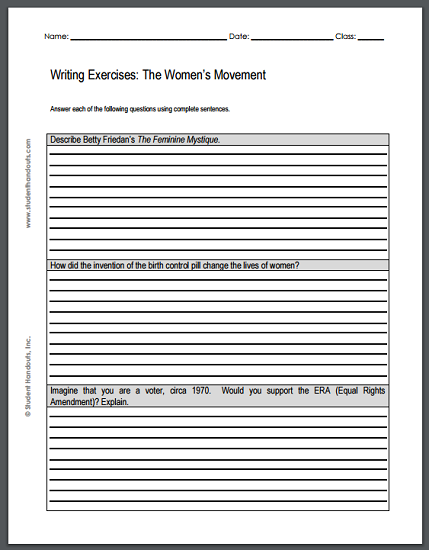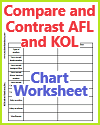| Women's Rights Movement Essay Questions |
|---|
| www.studenthandouts.com ↣ U.S. History ↣ Decades of Change ↣ Worksheets |
 |
    |
|
Questions: 1. Describe Betty Friedan's The Feminine Mystique. 2. How did the invention of the birth control pill change the lives of women? 3. Imagine that you are a voter, circa 1970. Would you support the ERA (Equal Rights Amendment)? Explain.
Click here to print. Answers will vary. The invention of the birth control pill dramatically changed the lives of women in several profound ways. Reproductive Autonomy: The pill gave women unprecedented control over their reproductive health, allowing them to decide if and when to have children. This autonomy led to greater personal freedom and life planning. Educational and Career Opportunities: With reliable birth control, women could pursue higher education and career goals without the interruption of unplanned pregnancies. This shift contributed to increased female participation in the workforce and higher education. Economic Independence: The ability to delay childbirth enabled women to establish themselves in their careers, leading to greater financial independence and stability. This economic empowerment had long-term benefits for women's social status and overall well-being. Health Benefits: Beyond preventing pregnancy, the pill offered health benefits such as regulating menstrual cycles, reducing menstrual pain, and lowering the risk of certain cancers, such as ovarian and endometrial cancer. Social and Sexual Liberation: The pill played a key role in the sexual revolution of the 1960s and 1970s, contributing to changing attitudes towards sex and relationships. It allowed women to separate sex from reproduction, promoting sexual freedom and agency. Shift in Gender Dynamics: The widespread use of the pill helped to shift traditional gender roles and dynamics. It supported the feminist movement by highlighting women's rights to make decisions about their own bodies and futures. Legal and Policy Changes: The availability of the pill influenced public policy and legal decisions, leading to greater support for women's reproductive rights and healthcare access. Overall, the birth control pill revolutionized women's lives by providing reproductive control, expanding educational and career opportunities, promoting economic independence, offering health benefits, facilitating sexual liberation, and contributing to shifts in gender dynamics and public policy. |
| www.studenthandouts.com ↣ U.S. History ↣ Decades of Change ↣ Worksheets |








